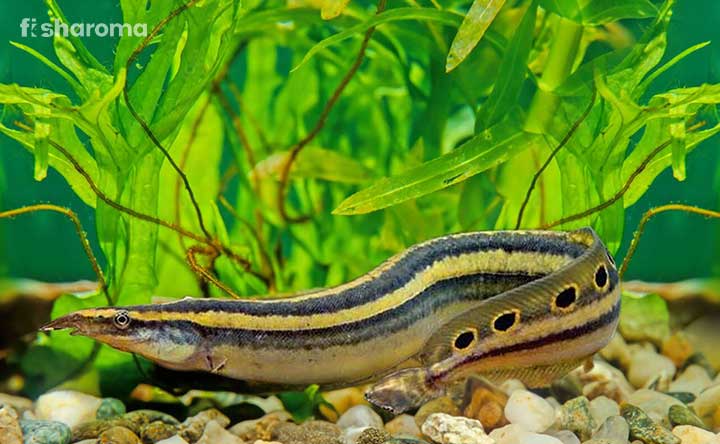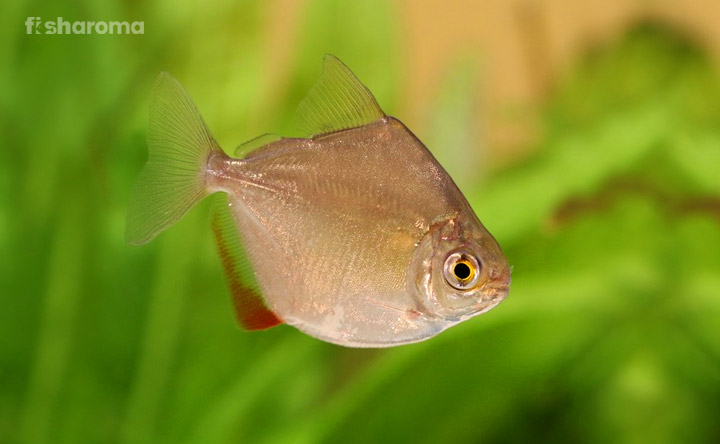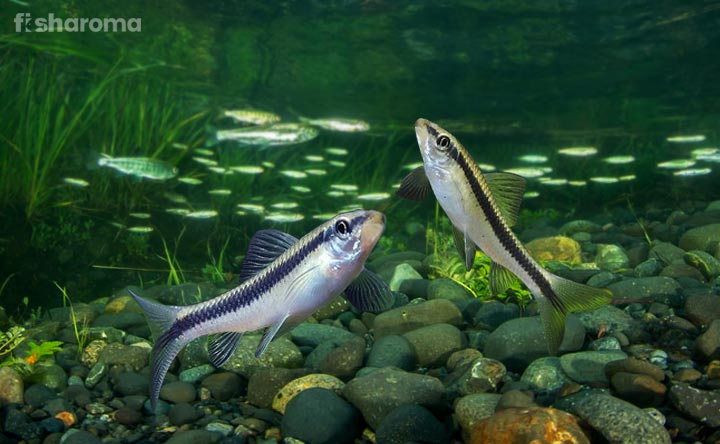Peacock Eel- A Care Guide To The Spotfin Spiny Eel

These magnificent tropical freshwater wonders are known by the name of Peacock Eel, based off of their eye-like spots around the dorsal fin. Also known by the names of Spotfin Spiny Eel, Peacock Spiny Eel or Siamese Spiny Eel, this beautiful breed looks flawless in the tank.
It is evident to find them fascinating, thus making it every aquarist’s dream. So if you are planning to own a few of these in your aquarium, you are in the right place. In this Peacock Eel Care Guide, we guide you through every detail you must get your hands on, before you finalize your ownership.
Key Specifications
Here goes a few key elements you need to check before you get started:
| Scientific Name | Macrognathus siamensis |
| Origin | Southeast Asia |
| Lifespan | 8-18 years |
| Colours/Patterns | Yellowish-greenTanEyespots near the fish’s rear. |
| Temperament | Semi-aggressive |
| Size | Up to 12 inches |
| Diet | Omnivorous |
| Family | Mastacembelidae |
| Compatibility | Compatible with any, except smaller or more aggressive species. |
| Tank size | 40 gallons |
| Care level | Advanced |
| Water preference | Freshwater |
Overview
The unique Peacock Eel is from the Mastacembelidae family, rooting from Asia. Although they possess an eel-like appearance, whilst in reality, they are just tropical fishes with an elongated body. Nevertheless, it might look challenging to care for them right off the bat, still sticking to the guidelines makes the entire responsibility smooth as butter.
Origin and Habitat of Peacock Eel
Originating from the lands of Asia, precisely the Southeast, this Peacock Eel fish is mostly found in the bottom of water bodies. To be exact, they are mostly found in regions like Chao Phraya, Mae Klong and Mekong of Southeast Asia.
They naturally belong to the brackish waters, in simpler words these freshwater fishes don’t really mind a bit of salt. The natural region from where these Eels come from are usually slow-flowing river bodies, or still waters, pretty dense with vegetation and other wonders of nature and wildlife.
Appearance of Peacock Eel
Peacock Eels do truly have a striking aura to them, especially with their distinguishable features, which are very interesting to witness from a perspective.
Let us delve deep into what exactly fascinates us about them:
Colour
The Peacock Eels have a yellowish-green base, which could be a bit on the tanned side at times. An eye-catching brighter yellow line appears to visually split the body into two halves, laterally, between the snout and the caudal fin. Moving on to the most striking feature, their eyespots. These eye-like spotted patterns near the fish’s rear are very noticeable in a good way and is probably something we remember these species by, from how beautiful they look all together.
Size
Peacock Eel fishes have a recorded size of max 12 inches, so in captivity, it is hard to expect from them to surpass that.
Behaviour of Peacock Eel
The Peacock Eel fish mostly survives in the bottom layer, so they are natural bottom-dwellers. Typical Eel behaviour is to burrow, so similarly, Peacock Eels being imminent burrowers, like to conceal their bodies in riverbeds. Still, it is a matter of concern when they start overdoing it in the tank. It is one of the first signs of them not getting enough hiding spots. The Peacock Eels may get stressed if their needs are not met, as they are quite sensitive in that department.
They are slow swimmers, but have a wander-type nature. The pace may not be up there, but the Peacock Eel often requires an extended tank space in order to have more room to swim happily. Other than that, they are nocturnal beings who are primarily not visible during the day time. The only time to see them in play is during night time when they are majorly active.
Lifespan of Peacock Eel
It can often be hard to state the exact lifespan of a species, but in the case of this Eel, it is more so. Unable to state an exact time, a Peacock Eel has been seen to survive anywhere between 8 to 18 years. In any case, conclusively, it is a decently good life expectancy.
Diet of Peacock Eel
As a result of their Omnivorous diet, the Peacock Eels have a lot to choose from. Good feeding practices not only help the fish to survive well, but also nourishes them as a whole. This nourishment and rejuvenation as a result make them look like their truest self, healthy and happy.
To provide you with a proper idea of what to be fed, let us go through this list:
- Mosquito Larvae (Insect)
- Bloodworms (Worms)
- Small tropical fish
- Brine Shrimp (Invertebrates)
- Frozen fish-food
- Dried fish-food
- Live fish-food
Tank Requirements for Peacock Eel
Tank requirements play a huge role, especially when you’re planning to have a well-structured aquarium with fishes in captivity. In the case of our target fish, Peacock Eel, you must do it all and provide thoroughly. Let us help you a little with that:
Tank Lid
The general importance of a tank lid is to protect the fish from jumping out. Additionally, they save the water from pollution as a result of exposure to harmful foreign particles. In the situation of Peacock Eels, they are known to be notorious jumpers from their elongated base shape. This certain characteristic of them trying to escape the tank, can cause serious damage or even prove to be fatal when they fall into their deaths. Fortunately, a tank lid prevents all of that from happening.
Tank Size
A tank size of at least 40 gallons is good, as they like to have enough room to explore and swim about in their respective aquarium space.
Substrate
A fine sand or gravel substrate (silt-like), which is soft and smooth is preferable. Substrate meeting the requirements above is necessary, as otherwise the burrowing nature of the Peacock Eels will not be supported, causing them injury.
Filter
Peacock Eel fishes don’t really produce much waste, still the sanity of tank water would benefit from the usage of a filter. That alone would highly contribute in making the water condition pristine again.
Ornaments
They are burrowers and we have already learned so much about them in the Substrate section. However, this much is clear, that they require a layer of the fine substrate to support that nature. This highlights the fish in its truest self which is extraordinary. Otherwise, the presence of enough hiding spots like driftwood, caves, pipes are good as ornaments.
Lighting
The lighting in a Peacock Eel tank should be subdued. A low-intensity lighting is closest to the emulation of situations in their natural habitat.
Presence of Flora
The presence of floating plants and glass-anchored grassy silk plants, works well as a replant. The term replant has been used, as these Eels have a tendency to uproot vegetation while burrowing.
Cleaning Method
The waste production in the case of Peacock Eels is not high, still, that does not cut you any slack from cleaning the aquarium properly. Keeping the tank clean from every aspect is necessary. Regular or relatively seasonal water changes, maintenance of the proper parameters, and keeping the tank walls clean is necessary.
Water Type for Peacock Eel
Water Type or the water parameters are of utmost importance. The health of the fish entirely relies upon how carefully you maintain the necessary water parameters. Apart from tank size or other requirements, the water profile plays a major role in balancing out the tank environment.
Thus, let us have a look at few parameters you need to be careful about:
| Hardness | 6-25 dH |
| Temperature | 22-26 Degrees Celsius |
| pH | 6.5-7.5 |
Hardness
A soft or rather towards a medium to hard water, rich in oxygen content is necessary for our precious Peacock Eel fish. Their range of consideration is high when it comes to this specific parameter, so a range of 6-25 DH is fitting.
Temperature
A temperature range of 22-26 Degrees Celsius is needed, as per our Eel’s comfort.
pH
pH is something that has been directly associated with the overall health of the fish, so our recommendation is to closely inspect and emulate the conditions of their natural habitat. A pH of 6.5-7.5 is ideal for our fish.
Compatibility of Peacock Eel
Peacock Eels, believe it or not, are quite docile and shy. However, they have been categorized as semi-aggressive. So, it is evident that they mostly go well with fishes they cannot feed on. In simpler words, the fish needs to be bigger than the size of their mouth. They are pretty compatible in case they are paired up with their kind, provided the tank condition is nice and cosy.
Suitable Tank mates
To give you a proper idea, let us mention some solid buddies you can pair them up with:
- Hatchetfish
- Rainbowfish
- Rasboras
- Swordtail fish
Unsuitable Tank mates
Small fishes or more aggressive fishes are a no-no, as one might just end up being prey and the latter being overwhelmers. Stress or preyed-upon tank mates is the last thing you would want for your tank.
Let us present you with a clear list of what to avoid at the time of choosing:
- Cardinal Tetra (all small Tetras)
- Guppy
- Whisker Shrimp (most small Shrimps)
- Other small invertebrates.
Breeding of Peacock Eel
When we move on to the topic of breeding Peacock Eel fishes, it is factually very complicated. Especially, in captivity, it can almost be deemed impossible to carry out. Even detecting their gender is complex, as the differences are vague. The female reaching maturity just appears to be slightly more plump, compared to the male. In the wild, usually the two fishes chase each other around a wide space, sometimes in circles at the time of the breeding process. However, in captivity, the possibility of that naturally occurring is slim.
Peacock Eel fishes lay eggs, which are usually sticky. The eggs latch themselves to some form of vegetation like floating plants, so in a tank, a spawning mop works too. Within a span of about 4 days, the fry can be seen hatching from their respective eggs. Once the yolk is gone as a result of absorption from the fry, they should be provided with rich feedable like infusoria. As the spawns slowly, but gradually become capable of swimming, feeding them nauplii is good. The young ones are highly prone to fungal infection, so the situation must be kept in check with precautions like anti-fungal treatments and so on.
Since spawning them is not exactly easy, in order to stimulate the process there have been several theories. Assumptions, such as a pretty constant addition of freshwater to an enclosed structure, could not only help with flooding, but trigger breeding as well. The entire scenario so mentioned is near to impossible to emulate in a real aquarium situation. Naturally, the success rate is very low, when it comes to the successful spawning process for the Peacock Eel.
Diseases of Peacock Eel
The Eels are highly prone to fungal infections as we have already learned a little in the Breeding section. Still, they are pretty susceptible to parasites and bacterias.
Let us name you some diseases that are capable of affecting our Peacock Eel’s health:
- Ich- We may also identify this disease with the term “White Spot Disease”.Originally known by the name of Ichthyophthirius multifiliis or as we know “Ich” is caused by a parasite. This nightmare of a disease for aquarium fishes, is textbook lethal to the health of our Peacock Eel.
- Bacterial and Fungal Infections- The Peacock Eel fishes have delicate skin, so a minimal scathe on the body can be an absolute feast for bacteria and fungus to infect.
Treatment
A few ways of prevention and treatment are as follows:
- Usage of Reef safe medications or half the dosage of normal medications, especially in the case of the Ich disease. The Peacock Eels are known to be pretty sensitive to medicines in general, so you must keep that in mind while treating them.
- You need to maintain the tank water quality, by having the closer look at proper parameters.
- The sick fish should be isolated immediately to a treatment tank, in order to get all the medical or remedial attention they need without contacting the ailment to the healthy lot.
- Paying attention to the fish for early signs, as quick detection can help the process better.
- Neglect is highly risky and taxing to the fish’s life, so we suggest you, to not put them in that position.
- Prevent stress, as a stressed fish is automatically more susceptible to diseases.
Summary
To summarize it all, Peacock Eel fishes are wonderful species of immense beauty and intricate detailing. Keeping them is not for the faint of heart, but with discipline to the proper guidelines, everything fits well like a puzzle piece. They have interesting traits like burrowing or wide swimming which is something that keeps us people in the hobby heavily hooked to the tank visuals.
The keeping for these beauties is well-balanced, as they can live for up to 18 years! So, if you are planning to make this worthy investment, we would suggest you to go for it and get these critters in your tank today.
Similar Care Guides
- Fire Eel Care Guide: Could be yours if not everyone’s cup of tea, these beautiful, yet peaceful Eels live up to 10 years, growing as big as 20 inches. Know more about these fascinating beings!
- Moray Eel Care Guide: These Carnivorous Eels have a moderate care level, coming in a wide range of vibrancies. Have a look!
- Spotted Garden Eel Care Guide: This saltwater species enhances the beauty of your aquarium with its unique burrowing technique. Know more about these very entertaining ray-finned beauties, right here.









